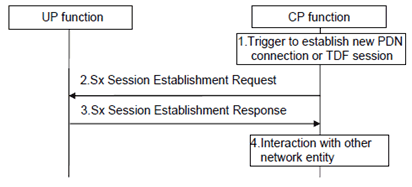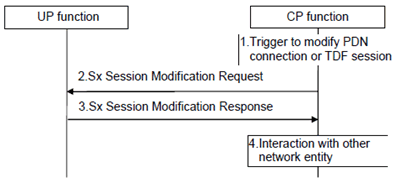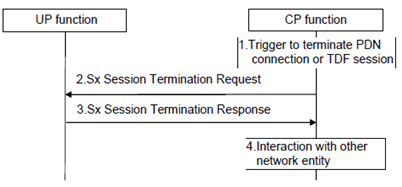Content for TS 23.214 Word version: 18.0.0
1…
4.3…
5…
5.6…
5.10…
6…
6.3…
6.3.1.2
6.3.1.3…
6.3.1.6…
6.3.2…
6.3.3…
6.3.3.4…
6.3.3.7…
6.3.4…
6.3.4.2…
6.3.4.2.2
6.3.4.3
6.4…
7…
6 Information flows
6.1 General
6.2 Sx Session Management Procedures
6.2.1 General
6.2.2 Sx Session Establishment Procedure
6.2.3 Sx Session Modification Procedure
6.2.4 Sx Session Termination Procedure
...
...
6 Information flows p. 35
6.1 General p. 35
This clause defines the procedures that are used for the interaction between SGW-C and SGW-U, PGW-C and PGW-U, TDF-C and TDF-U, and documents how these procedures shall be embedded into existing procedures of TS 23.401, TS 23.402, TS 23.060 and TS 23.203.
6.2 Sx Session Management Procedures p. 35
6.2.1 General p. 35
Sx session management procedures are used to control the functionality of the UP function, which involve SGW, PGW or TDF. The CP function can create, update and remove the Sx session context (i.e. the parameters related to a PDN connection, IP-CAN session, TDF session or TDF in unsolicited reporting mode) in the UP function.
The following Sx session management procedures exist: Sx session establishment procedure, Sx session modification procedure and Sx session termination procedure. All of them are initiated by the CP function.
6.2.2 Sx Session Establishment Procedure p. 35
The Sx session establishment procedure is used to create the initial Sx session context for a PDN connection, IP-CAN session, TDF session or TDF in unsolicited reporting mode at the UP function. The CP function assigns a new Session ID and provids it to the UP function. The Session ID is stored by both entities and used to identify the Sx session context during their interaction. The CP function stores also the relation between the Session ID and PDN connection, IP-CAN session, TDF session or TDF in unsolicited reporting mode and can then correlate events reported by the UP function to them.
During PDN connection establishment, the Sx session establishment procedure is executed between SGW-C and SGW-U as well as PGW-C and PGW-U. The Sx session context comprises the parameters for the default as well as every dedicated bearer of the PDN connection. In addition, the Sx session context for the PGW-U comprises IP-CAN session related parameters.
During SGW-U relocation, the Sx session establishment procedure is executed between SGW-C and the target SGW-U. The Sx session context comprises the parameters for the default as well as every dedicated bearer of the PDN connection.
During TDF session establishment, the Sx session establishment procedure is executed between TDF-C and TDF-U. The Sx session context comprises TDF session related parameters.
For a TDF in unsolicited reporting mode, the Sx session establishment procedure is executed between TDF-C and the TDF-U selected during Sx management procedure. The Sx session context comprises the instructions for application detection and reporting in unsolicited reporting mode.

Step 1.
CP function receives the trigger to establish a new PDN connection or TDF session from a peer CP function, an MME or a PCRF.
Step 2.
The CP function sends an Sx session establishment request message to the UP function that contains the structured control information which defines how the UP function needs to behave.
Step 3.
The UP function responds with an Sx session establishment response message containing any information that the UP function has to provide to the CP function in response to the control information received.
Step 4.
The CP function interacts with the network entity which triggered this procedure (e.g. a peer CP function, an MME or a PCRF).
6.2.3 Sx Session Modification Procedure p. 36
The Sx session modification procedure is used to update the Sx session context of an existing PDN connection, IP-CAN session, TDF session or TDF in unsolicited reporting mode at the UP function.
The Sx session modification procedure is executed between SGW-C and SGW-U whenever PDN connection related parameters have to be modified, as well as between PGW-C and PGW-U whenever PDN connection or IP-CAN session related parameters have to be modified.
The Sx session modification procedure is executed between TDF-C and TDF-U whenever TDF session related parameters have to be modified.
For a TDF in unsolicited reporting mode, the Sx session modification procedure is executed between TDF-C and TDF-U whenever instructions for application detection and reporting have to be modified.

Step 1.
CP function receives the trigger to modify the existing PDN connection or TDF session from a peer CP function, an MME or a PCRF.
Step 2.
The CP function sends an Sx session modification request message to the UP function that contains the update for the structured control information which defines how the UP function needs to behave.
Step 3.
The UP function identifies the Sx session context to be modified by the Session ID. Then, the UP function updates the parameters of this Sx session context according to the list of parameters sent by the CP function. The UP function responds with an Sx session modification response message containing any information that the UP function has to provide to the CP function in response to the control information received.
Step 4.
The CP function interacts with the network entity which triggered this procedure (e.g. a peer CP function, an MME or a PCRF).
6.2.4 Sx Session Termination Procedure p. 37
The Sx session termination procedure is used to remove the Sx session context of an existing PDN connection, IP-CAN session, TDF session or TDF in unsolicited reporting mode at the UP function.

Step 1.
CP function receives the trigger to terminate the existing PDN connection or TDF session from a peer CP function, an MME or a PCRF.
Step 2.
The CP function sends an Sx session termination request message to the UP function.
Step 3.
The UP function identifies the Sx session context to be terminated by the Session ID and removes the whole session context. The UP function responds with an Sx session termination response message containing any information that the UP function has to provide to the CP function.
Step 4.
The CP function interacts with the network entity which triggered this procedure (e.g. a peer CP function, an MME or a PCRF).